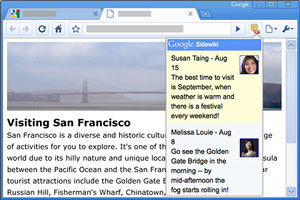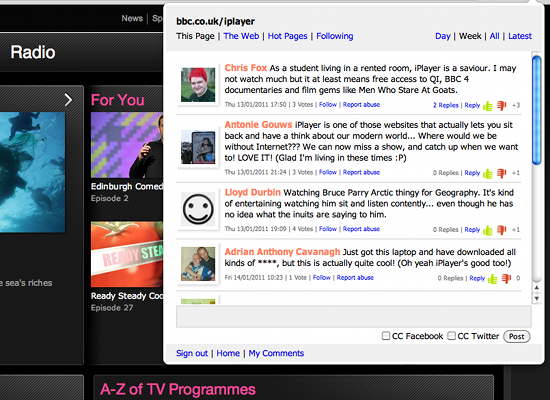
 TNW Quick Look
TNW Quick Look
Billed as a new “Social surfing” layer for the web, Pushnote is a browser plugin that allows you to comment on any webpage. It includes social features that let you follow friends’ comments and find the current hot topics being discussed across the Web.
Hits:
- Commenting is quick and easy, with real-time updates when new comments arrive.
- Notification ‘light’ on plugin makes it easy to see when new comments have arrived.
- Entire service can be navigated from within the browser plugin. Little need to visit the Pushnote site.
Misses:
- Signup process can be slow.
- No plugin for Safari yet.
- No way to edit or delete comments
The details
New Web commenting system Pushnote has launched in a blaze of publicity thanks to the backing (both financial and via a tweet to his two million Twitter followers) of one Stephen Fry. Is it actually any good though? We dived in to take a look.
The product of a UK-based startup, Pushnote is a browser plugin that allows you to comment on any webpage. Simply click the Pushnote button, leave a comment and all other users of the service will see it in their plugin next time the visit that page. The plugin lights up green if there’s a new comment to read on the current page you’re looking at.
Pushnote has a number of social features baked in. Comments can be voted up and down and users can leave follow-up replies to individual comments. You can follow individual users, and you’ll see that the plugin lights up red if any of your friends have left a new comment anywhere on the Web. The plugin also highlights the current “Hot Pages” around the Web that are receiving a lot of Pushnote comments. Comments can be shared to Twitter and Facebook, with a link back to the Web page in question.
Teething troubles
 Signing up to the service, we did wonder if Pushnote had bitten off more than it could chew by launching in a blaze of rather more mainstream publicity than most Web startups do. The user signup process for us was slow and buggy, requiring a few browser refreshes to successfully follow our Twitter and Facebook friends on the new service.
Signing up to the service, we did wonder if Pushnote had bitten off more than it could chew by launching in a blaze of rather more mainstream publicity than most Web startups do. The user signup process for us was slow and buggy, requiring a few browser refreshes to successfully follow our Twitter and Facebook friends on the new service.
Plugins are currently available for Chrome, Firefox and Internet Explorer, meaning that for now Safari users are out of the loop.
The social side of the service needs work too. While it’s great to see what’s popular around the web right now, the most commented-on pages at the time of writing include the Facebook homepage and the Twitter homepage – not exactly the most exciting destinations on the Web. A way to filter down to “interesting” pages would be useful, although the ability to follow friends makes finding slightly more engaging content easy – if you follow the right people.
Puzzlingly, there’s no way to edit or delete comments. This means that if you make a typo or (like me) accidentally post a comment twice – you’re stuck.
It’s worth noting that Pushnote is still in beta and all these problems may well be fixed soon. Still, launching a service with a rush of hype before it’s quite ready for the prime time does seem a little strange.
So, will Pushnote take off?
 Anyone who’s used Google’s largely ignored SideWiki service will know where Pushnote is coming from. Leaving comments on a service detached from the actual Web page has benefits and disadvantages.
Anyone who’s used Google’s largely ignored SideWiki service will know where Pushnote is coming from. Leaving comments on a service detached from the actual Web page has benefits and disadvantages.
On one hand, Pushnote offers a social discussion service for the whole Web in one place that’s always just a click of a browser button away, with link discovery built right in thanks to the ability to follow other users and see what they’re commenting on. It does away with the need for signing up to multiple website comment accounts and takes all of the ‘friction’ out of leaving a comment, which in theory could boost the number of comments a page gets if the service takes off.
On the other hand, while there’s a real need for detached comments on certain pages – namely those that don’t offer any native comment system themselves, traditional on-page comments for news articles have a real benefit. Let’s say you spotted a grave error in a news report. If you leave a comment on the page’s own comment system, it alerts both other readers and the writer about the mistake. If you leave it on Pushnote instead, the writer and other readers will only ever see your message if they’re fellow Pushnote users and think to check the plugin while they’re on that page.
That said, these arguments are old ones. Before Google tried this with SideWiki, there were already a number of similar ‘Web annotation’ services. While Pushnote offers some strong social features, it will only become a true “social layer for the Web” if it can succeed where all those other services failed. Ultimately, even the influential Stephen Fry can’t decide this one.
Pushnote is free and available to sign up to now.
Get the TNW newsletter
Get the most important tech news in your inbox each week.




![Serenading Stephen Fry: “Please let me have your baby” [Video]](https://img-cdn.tnwcdn.com/image?fit=2361%2C1161&url=https%3A%2F%2Fcdn0.tnwcdn.com%2Fwp-content%2Fblogs.dir%2F1%2Ffiles%2F2011%2F03%2F144.jpg&signature=7cf42627a76c1850d20bc283bfe41ba1)


![Stephen Fry Dissects Twitter on Late Late Show in the US [VIDEO]](https://img-cdn.tnwcdn.com/image?fit=1167%2C765&url=https%3A%2F%2Fcdn0.tnwcdn.com%2Fwp-content%2Fthemes%2Fcyberdelia%2Fassets%2Fimg%2Fplaceholder%2Fbg-1.png&signature=e4d5b3af7f0ac4c57df92128846827a6)
